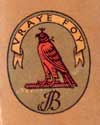Thu 17 Jun 2004
Reviews of The Fencing Master
Posted by boz under BooksComments Off on Reviews of The Fencing Master
REVIEW BY CLAY STAFFORD
The Fencing Master is a mystery set in the mid-1800s, when Queen Isabel II was on the Spanish throne and a revolution was in the making. There is an interesting analogy throughout between the art of fencing (context), the more symbolic art of love (theme), and the art of political revolt (place). All are subtly tied together.
The fencing master, Jaime Astarloa, is nearing retirement. Before his death, he has one goal: A fencing move from which there is no parry, or countermove. He calls it the Holy Grail, the thrusting move for which there is no defense. Other characters include a gambler, womanizer, and member of the Queen’s court; a disillusioned priest turned journalist; a snobbish man of noble birth whose family has run out of money; a piano teacher who once dreamed of greatness and is sadly in love; and a beautiful, mysterious woman. These characters are the mystery and to tell more would almost give the mystery away.
The Fencing Master is the story of a man’s life, of passion, of making a difference. It is a mystery of the life in every day. Feelings and intuition cannot be grasped and examined like a piece of art. Yet, as the fencing master learns, they can be analyzed in hindsight like a good match of foils: deliberate thrusts, deliberate feints. In the beginning, we find only a fencing master searching for the perfect thrust, who wishes to live his last days in peace, reliving only the joys of his past, finding macabre consolation that his days are numbered, and making his humble way by teaching the passing gentleman’s art of fencing in a disillusioning new world ruled by revolvers and firearms. Quickly, though, he realizes that life will not grant him any such peace in his old age. As with many a man’s sleepless nights and the answer to many of life’s mysteries, a single thought begins them all: “There was a woman . . .”
By Diane Carman
Denver Post Staff Writer
THE FENCING MASTER
By Arturo Perez-Reverte
Harcourt Brace, $24
June 20 – Even in 19th century Spain there were few gentlemen. Avarice, deceit, corruption and lust for power ruled the day. Her Catholic Majesty Queen Isabel II was not safe, even in her royal home.
But amid all this political and social turmoil there was one pure and virtuous man, Jaime Astarloa, the fencing master.
In Arturo Perez-Reverte’s novel, “The Fencing Master,” Don Jaime comes to life as a richly drawn anachronism, a man of unshakable honor and almost divine skill as a fencer. His humility and modesty only serve to elevate him above the petty quarrels of common men who rely on more modern weapons and tedious conspiracies to enforce their will.
Don Jaime was no longer a young man, and he dressed as if from another era. His clientele had dwindled over the years, but among his most regular students was Luis de Ayala-Velate y Vallespin, the Marques de los Alumbres.
Don Luis was a legendary ladies’ man, rumored to have dabbled in a love affair with the queen, and certainly a powerful and influential man within the elite.
Don Jaime also frequented the Cafe Progreso where rumors of coups and insurrections were rife, especially from his friend Agapito Carceles, who wrote for various revolutionary publications.
Carceles’ two “bete noires were the clergy and the monarchy, and he believed ardently that the two most important contributions to the history of humanity had been the printing press and the guillotine.”
Into this simmering environment in Madrid appears Doña Adela de Otero.
And now things really start to get hot.
Doña Adela is ravishing. Her violet eyes and abundant black hair, her lean, muscular body and her soft-spoken directness have served her well when it has come time to seduce any man. Her appearance takes Don Jaime’s breath away.
But at first her request that he teach her the “two-hundred-escudo thrust” is too much to ask. “I would never teach fencing to a woman,” he said.
“Times change,” she responds.
Sure enough, in no time she has persuaded him to take her on as a student.
The fencing scenes are rich in detail and highly technical. But they also are almost like lovemaking for Don Jaime and Doña Adela. Perez-Reverte is extraordinary in creating a vivid metaphor of lunges and parries that even those uninitiated to the language of fencing understand implicitly.
The political turmoil, however, is harder to follow and deliberately so.
This is a period of intrigue and betrayal, and Perez-Reverte foreshadows the bloody denouement of this thriller obliquely so that when it finally comes it has maximum impact.
Only Don Jaime is more stunned by events than the reader, because it takes him to the very end of this intricate tale to realize what danger lurks behind those violet eyes.
And the brilliant final fencing match is pure poetry.
